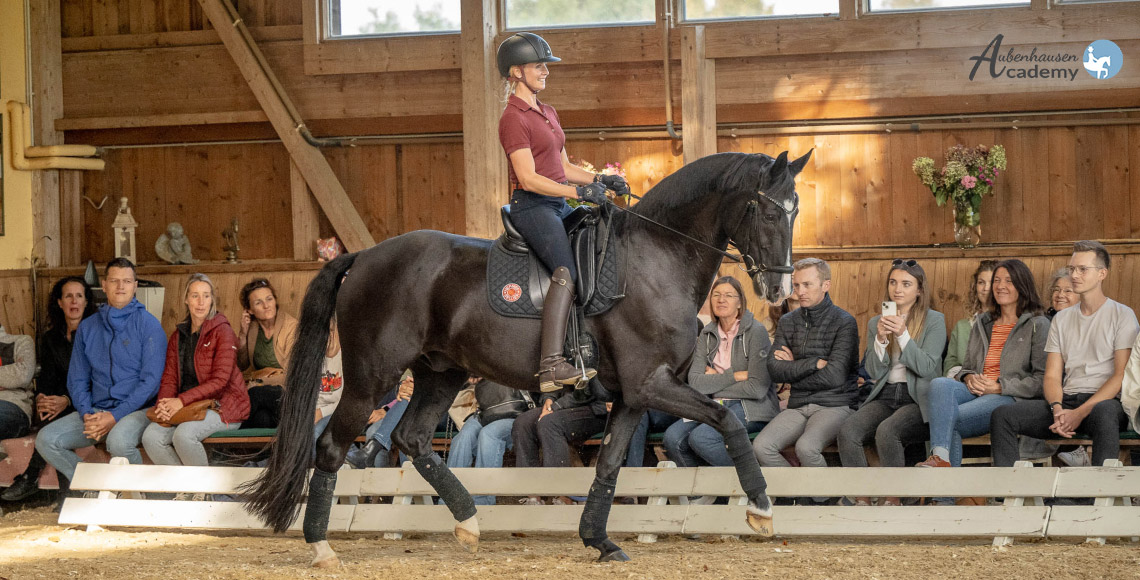
Learning from Other Riders
Not only children learn by watching and mimicking others. Even for adults, learning from others by observing is an important factor to further skill development. Scientific studies have shown that observational learning activates certain neurons in the brain that enhance the learning process. Additionally, the brain responds when a movement is being observed that is already known from one’s own experience. The mental aspect of motor learning – this is also true for riding – plays an important, not to be underestimated role.
What exactly does that mean for riders?
We can learn a lot by watching others train. This should be a positive being with one another and positive learning from one another – not a search for mistakes. By watching others and analyzing their rides, we can see different approaches and gain new perspectives for our own training. Furthermore – and that’s pretty cool – you can subconsciously learn new movement patterns and copy good riding.
Have you noticed that we take on certain phrases, words, or idioms from people with whom we spend a lot of time? Subconsciously, we copy quite a bit! To watch very good riders and our role models is not only a lot of fun, it also rubs off on us a little bit. Therefore it makes a lot of sense to deliberately and often watch those riders from whom we want to learn.
Fun-Fact: This is also a great side-effect of online courses. You are not only learning the concepts, but by repeatedly watching, your subconscious will also copy movement patterns.
Jessica von Bredow-Werndl also likes to find inspiration in other riders
“I have always loved getting input from other riders. For example, for many years now I’ve been incorporating the advice given by Ingrid Klimke and Michael Jung regarding equine fitness into my training. I continually want to grow and that makes staying inspired imperative.”
Learning from role models
Benjamin Werndl says: “Of course I watch other riders and learn a lot from them. Primarily this comes from the fact that we can put ourselves in their shoes. When we watch a horse and imagine sitting up there, we can see how the rider approaches a situation and store that in our toolbox. The advantage of our setup at Aubenhausen is that we’re a network of world class riders who all watch one another and also sit on each other’s horses which allows us to draw conclusions. Throughout my career I’ve had many coaches, and of course I had role models when I was a kid. But at some point, I also got to learn that it’s important for me not to try to ride exactly like somebody else, but to ride the way I am and according to what I’m feeling. That’s why I typically avoid comparisons. If I were to compare myself to others all day long, it would eventually demotivate me. I have learned to focus on myself and to achieve and feel the optimum for myself and my horse. At the same time, it is important to be inspired, as a child as well as later in life. I know that we are now also an inspiration to the younger generation. However, I’d like to invite everyone to stay tuned into themselves and into their horse, and find your own path – just not with blinders on!”

How Raphael Netz gets inspired to new training approaches
Three-time U25 European champion Rafael Netz adds: “I love watching other riders, especially at a show, both in the warm-up and in the test. I try to get some inspiration around the topic I think about the most at the time. For example, when I know that with a particular horse, the piaffe could be a bit better but I’m not exactly sure what to try, I explicitly observe really excellent riders in the piaffe or the warm-up for the piaffe. I watch very closely and try to analyze the movement by its optics. Jessica and Benjamin are very special teachers to me who have definitely shaped me.”
There are many different ways to learn from others
There are many different ways to watch others ride – not only live and on location but also online. Tests at shows and training videos are readily available – anywhere, any time. Online courses provide factual input and knowledge, and at the same term we subconsciously learn movement patterns and strengthen our muscle memory. The courses in our Aubenhausen Academy show the entire training process for a variety of movements with many different horses. To stay with the example of the piaffe, here, we start playfully introducing the first aids for the work in hand on the ground to our 4-year-olds. Of course that’s not a piaffe yet, but it’s the beginning. This way there is something for everyone in each course, no matter at what level horse and rider currently are.
Come have a look and remember: Your subconscious is learning too! Click here and check out our dressage masterclasses in our Aubenhausen Academy!
